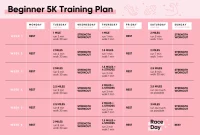Looking to take your athletic performance to the next level? In this article, we delve into the world of advanced sports training, going beyond the basics and exploring cutting-edge techniques and strategies that will help you excel in your chosen sport. Unlock your full potential and elevate your game with our expert tips and insights.
Integrating High-Intensity Interval Training (HIIT)
High-intensity interval training (HIIT) has emerged as a popular and effective training method for athletes looking to take their performance to the next level. Unlike traditional steady-state exercise, HIIT involves short bursts of intense activity followed by brief recovery periods. This article explores the benefits and considerations of integrating HIIT into advanced sports training.
One of the main advantages of HIIT is its efficiency. With HIIT, athletes can achieve maximum results in less time compared to longer, moderate-intensity workouts. The intensity and variation in exercises demand greater effort from the cardiovascular system, resulting in improved aerobic capacity and increased muscle strength.
Furthermore, HIIT can enhance fat loss and metabolic rate due to the post-exercise oxygen consumption effect, commonly known as the “afterburn” effect. This means that the body continues to burn calories even after the workout is complete. This can be particularly beneficial for athletes who are aiming to optimize their body composition for their sport.
Integrating HIIT into advanced sports training requires careful planning and consideration. Athletes should consider their specific sport, performance goals, and individual fitness levels. It is crucial to design a training program that balances HIIT sessions with other forms of training, such as strength and endurance exercises, to ensure a well-rounded and comprehensive approach to training.
Additionally, it is essential to monitor training load and recovery to prevent overtraining and injuries. Proper warm-ups and cool-downs, as well as adequate rest periods between HIIT sessions, are vital for optimizing performance and reducing the risk of injuries.
In conclusion, integrating high-intensity interval training (HIIT) into advanced sports training can provide significant benefits for athletes. Its efficiency, ability to enhance fat loss, and positive impact on aerobic capacity and muscle strength make it a valuable addition to training routines. However, careful planning, consideration of individual needs, and monitoring of training load and recovery are crucial for a successful integration of HIIT into training programs.
Sport-Specific Conditioning Techniques
In the realm of advanced sports training, athletes are constantly seeking new and innovative methods to enhance their performance. One crucial aspect of this is sport-specific conditioning. To excel in their chosen sport, athletes must tailor their training regimens to mimic the demands of the game or event. This requires a deep understanding of the specific skills, movements, and energy systems involved in their sport.
1. Plyometric Training
Plyometric exercises aim to develop explosive power and improve quickness and agility. Athletes engage in activities such as box jumps, depth jumps, and medicine ball tosses to enhance their ability to generate force rapidly. These exercises mimic the explosive movements required in many sports, such as basketball, volleyball, and sprinting.
2. Interval Training
Interval training involves alternating periods of high-intensity exercise with periods of rest or lower intensity. This method is highly effective in improving an athlete’s cardiovascular endurance and anaerobic capacity. For instance, soccer players often utilize interval training to simulate the intermittent nature of their sport, which requires bursts of high-intensity sprints followed by brief recovery periods.
3. Resistance Training
Resistance training is essential for enhancing overall strength and power. Athletes incorporate exercises using free weights, machines, or their body weight to target specific muscle groups involved in their sport. For example, swimmers focus on exercises that strengthen their shoulders and core, while weightlifters concentrate on developing maximum strength and explosiveness.
4. Balance and Stability Training
Balance and stability are crucial components in many sports, especially those involving dynamic movements or environmental challenges. Athletes train their proprioceptive system through exercises such as single-leg exercises, Bosu ball drills, or yoga to improve body control and prevent injuries. This training is particularly valuable for sports like gymnastics, surfing, and skiing.
5. Sport-Specific Drills
Incorporating sport-specific drills into training provides athletes with an opportunity to refine their skills, tactics, and decision-making abilities. These drills are designed to closely replicate the movements and scenarios encountered in the actual sport. For instance, basketball players might focus on dribbling and shooting under pressure, while tennis players hone their serve and volley techniques.
By utilizing these sport-specific conditioning techniques, athletes can take their training to the next level. They allow for targeted development of the physical attributes necessary to excel in a particular sport, giving athletes a competitive edge. It is important, however, to consult with a qualified coach or trainer to ensure proper programming and technique execution.
The Role of Recovery in Training
Recovery plays a crucial role in advanced sports training. It is often overlooked by athletes who focus solely on intense workouts, but neglecting proper recovery can hinder progress and increase the risk of injuries.
During training, the body undergoes various stressors and micro-damage to muscles, tendons, and joints. Recovery allows the body to repair and rebuild these tissues, making them stronger and more resilient. Additionally, it replenishes energy stores, balances hormones, and enhances mental focus.
There are several key components of effective recovery. First and foremost is rest. Providing sufficient time for rest allows the body to replenish energy reserves and initiate the repair process. Active recovery, such as light exercises or low-intensity cross-training, can also aid in promoting blood flow and reducing muscle soreness.
Another important aspect of recovery is nutrition. Consuming a well-balanced diet that includes an adequate amount of protein, carbohydrates, and healthy fats provides essential nutrients to support muscle repair and growth. Hydration is equally crucial, as it enhances nutrient delivery and aids in toxin removal.
Sleep is often underestimated but is essential for optimal recovery. During sleep, the body releases growth hormone, which aids in repairing and rebuilding tissues. Aim for 7-9 hours of quality sleep per night to maximize recovery benefits.
Lastly, incorporating various recovery techniques can expedite the healing process. This can include stretching, foam rolling, massage therapy, ice baths, and contrast showers. These techniques help reduce inflammation, improve flexibility, and relieve muscle tension.
Advanced sports training requires a holistic approach that includes both intense workouts and proper recovery strategies. Ignoring recovery can lead to overtraining, plateauing, and increased susceptibility to injuries. By prioritizing rest, nutrition, sleep, and employing recovery techniques, athletes can achieve optimal performance and long-term success.
Overcoming Mental Barriers in Sports
In the world of advanced sports training, athletes need to go beyond the basics and focus on overcoming their mental barriers. While physical abilities play a crucial role in sports performance, a strong mindset is equally important in achieving success.
The Power of Mental Resilience
One of the primary mental barriers in sports is the fear of failure. Athletes often find themselves trapped in a cycle of self-doubt, which affects their confidence and performance. Overcoming this barrier requires developing mental resilience.
Athletes can build mental resilience by embracing failure as an opportunity for growth. They should learn from their mistakes, reflect on what went wrong, and use this knowledge to improve their skills. By reframing failure as a stepping stone to success, athletes can strengthen their mental fortitude and perform at their best under pressure.
Visualization and Goal Setting
Visualization and goal setting are powerful techniques that can help athletes overcome mental barriers. By visualizing success and setting clear goals, athletes create a roadmap for achievement and boost their confidence.
Visualization involves mentally rehearsing specific sequences of actions required in a sport. Athletes imagine themselves executing flawless techniques, scoring goals, or performing at their peak. Through consistent visualization, athletes develop a strong belief in their abilities, allowing them to overcome doubts and perform with more focus and precision.
In addition to visualization, goal setting provides athletes with a clear direction and motivation. By setting specific, measurable, attainable, relevant, and time-bound (SMART) goals, athletes can break down their journey into smaller steps. This strategy helps them stay focused, maintain motivation, and overcome mental barriers that may arise along the way.
The Role of Positive Self-Talk
Positive self-talk is a powerful tool that athletes can use to overcome mental barriers. Instead of listening to negative thoughts or self-doubt, athletes should cultivate a positive inner dialogue.
By replacing negative thoughts with positive affirmations, athletes can boost their confidence, maintain focus, and stay motivated. Encouraging phrases like “I can do it,” “I am strong,” or “I am prepared” can help athletes overcome self-imposed limitations and reach their full potential.
Conclusion
In advanced sports training, athletes must recognize and address their mental barriers to excel. By developing mental resilience, utilizing visualization and goal setting techniques, and practicing positive self-talk, athletes can overcome these obstacles and unlock their true potential. It’s not just about physical strength, but also about mental strength, determination, and belief in oneself.
Utilizing Wearable Tech for Training Insights
Advances in technology have revolutionized the world of sports training by introducing wearable tech devices that provide invaluable insights and data. These devices go beyond the basics, offering athletes and trainers a deeper understanding of their performance and allowing them to optimize their training routines.
Wearable tech devices such as fitness trackers, smartwatches, and heart rate monitors have become increasingly popular among athletes of all levels. These devices track various metrics such as heart rate, calories burned, distance covered, and even sleep quality. By collecting this data, athletes can gain insights into their physiological responses to different training exercises and adjust their routines accordingly.
The real-time feedback provided by wearable tech devices is another crucial feature that takes sports training to the next level. Athletes can monitor their performance during training sessions, receiving immediate notifications and alerts regarding their heart rate zones, pace, and intensity levels. This data helps them to push their limits and achieve optimal performance.
Wearable tech devices also enable trainers to analyze the training progress of their athletes more effectively. By aggregating data from multiple individuals, trainers can identify trends and patterns, enabling them to tailor training programs to meet the specific needs and goals of each athlete. This individualized approach enhances performance and minimizes the risk of injuries.
Additionally, wearable tech devices foster motivation and accountability. Through features like goal setting, challenges, and social sharing, athletes can track their progress, compete with others, and stay connected with a community of like-minded individuals. This sense of community and feedback further fuels their passion and desire to excel.
In conclusion, the utilization of wearable tech devices in sports training goes beyond the basics, providing athletes and trainers with valuable insights and data. By leveraging these devices, athletes can optimize their training routines, monitor their performance in real-time, and strive for continuous improvement. Trainers can personalize their programs and ensure athletes are on the right track to achieving their goals. With wearable tech, the possibilities for advanced sports training are endless.
Conclusion
In conclusion, advanced sports training goes beyond the basics and requires a combination of dedication, determination, and proper techniques. It is essential for athletes who want to reach the next level and achieve their full potential. By incorporating specialized exercises, mental strategies, and advanced training methods, athletes can enhance their performance and excel in their respective sports.




